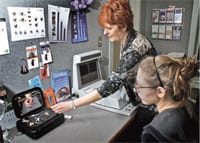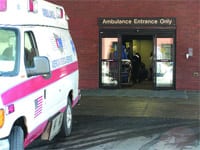50 Years of Small Miracles The Speech & Hearing Center at HMC Marks a Milestone
Three-year-old Ryan Serrano had spoken five words before he started speech/language therapy at Holyoke Medical Center’s Speech & Hearing Department.
Within six months he was communicating verbally using 200 words, thrilling his mother, Yasmin Serrano of Holyoke.
“He has made so much progress. It is amazing what they have done with my son,” Serrano said.
For 50 years, the Speech & Hearing Center has performed such small miracles for thousands of families, adults, and children in the Greater Holyoke community and beyond, said manager and audiologist Janice Walker.
“We’re still here, and our services are still essential; I continue to be amazed by this place that is a department of the hospital and a well-established heart of the community,” Walker said. “At the end of the day, you’ll find us sitting together to talk about how we can continue to improve and expand the services we’ve been providing for five decades.”
Highly experienced, multi-talented, and flexible speech language pathologists, audiologists, and a hearing-instrument specialist work as a team, providing state-of-the-art communication services to hospital inpatients and outpatients from birth to beyond 90.
They treat children with hearing loss affecting their speech-language development, work with autistic children and perform auditory processing evaluations, help with dysphasia feeding and swallowing difficulties, and employ augmentative/alternative communication equipment, said Walker. About 50{06cf2b9696b159f874511d23dbc893eb1ac83014175ed30550cfff22781411e5} of the audiology service is fitting adult hearing aids.
Staff members also partner with community agencies to better serve patients, including the Massachusetts Rehabilitation Commission, which helps employed adults obtain hearing aids not covered by insurance; the May Center; the Massachusetts Society for the Prevention of Cruelty to Children; Criterion Heritage for early intervention (birth to age 3) and preschool children to advance language development; and local visiting nurse associations to help stroke patients and perform home visits.
A speech-rehabilitation clinic was begun by the Junior League in 1962 in the historic Skinner Clinic Building, which once treated polio patients, provided free health services to the uninsured, and housed a dental and eye clinic.
Dr. L. Albert Webb, an optometrist who volunteered at the clinic in the 1950s, now visits as a hearing-aid patient.
“The legacy is the history of the Skinner Clinic, dating to 1916,” said Webb. “It has been my privilege to know many of the men and women recorded in that history. The center provides [care] without the commercialization, but with honest evaluation and service.”
In 1967, the Speech & Hearing Center was founded by Esmat Ezzat, a tireless fund-raiser who expanded the center to include many of the essential services it still provides today.
“The center had its beginning in one small room with one therapist, and today, thanks to fund-raising that exceeded expectations, it has expanded to include a state-of-the- art facility,” said Ezzat. “Over the years, the center has been recognized as a valuable link between various community agencies, schools, rehab centers, physicians, and universities. It has been the site for a multi-agency developmental clinic, a support group for stroke patients, a local resource for the training of medical students and physicians, and, most of all, a center for excellence in providing clinical services.”
Ezzat credits the center’s success to staff’s cohesive teamwork, performed with a “great passion and respect for all,” which sets them apart.
“The demands we face today include an unpredictable economy, a very competitive specialized marketplace, changing demographics, and uncertain reimbursement systems. It is critical that we continue to set ourselves apart and to work with families and educators, so as to narrow the gap between knowledge and actual service provision,” she said. “We need to have a great passion for the field and take advantage of technology.”
Technology has improved tremendously, said 24-year staffer Sheila Jolivet, who remembers fixing hearing aids with screwdrivers and updating patients’ records on a typewriter.
“What hasn’t changed,” she said, “is that it’s still a nice, small community hospital where everybody knows everybody.”



Comments are closed.